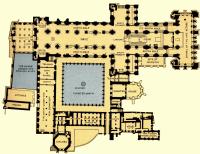


Abbeys
An abbey was a monastery built by the church and nearly, if not completely, self-sufficient. Monks were under the government of an abbot or prior; nuns were under the government of an abbess. Most abbeys took their names from their setting, their founders, a saint with a relic in or associated with the abbey, or an important monk associated with the abbey. Abbeys were typically solitary places, similar in function and purpose to nunneries. St. Pachomius is recorded as the first to construct a building with the purpose of housing a community of solitaries (perhaps a contradiction in terms), as nuns and monks collectively were called. He built several monasteries in Upper Egypt.
The abbey was essentially a walled village, containing usually around 1,600 cells or dorms for monks. There were large halls for common needs, however: the infirmary, the refectory, the kitchen, and a guest-house. Abbeys were built simply, reflecting the lifestyle of those within, without decoration or flamboyant architectural style. They were built for function, not for style, but they are even so beautiful in their simplicity.
For more information:
Thanks to Pen Peregrin for helping with research on this section.
Click to enlarge.